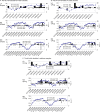Ecology of Vibrio parahaemolyticus and Vibrio vulnificus in the coastal and estuarine waters of Louisiana, Maryland, Mississippi, and Washington (United States)
- PMID: 22865080
- PMCID: PMC3457101
- DOI: 10.1128/AEM.01296-12
Ecology of Vibrio parahaemolyticus and Vibrio vulnificus in the coastal and estuarine waters of Louisiana, Maryland, Mississippi, and Washington (United States)
Abstract
Vibrio parahaemolyticus and Vibrio vulnificus, which are native to estuaries globally, are agents of seafood-borne or wound infections, both potentially fatal. Like all vibrios autochthonous to coastal regions, their abundance varies with changes in environmental parameters. Sea surface temperature (SST), sea surface height (SSH), and chlorophyll have been shown to be predictors of zooplankton and thus factors linked to vibrio populations. The contribution of salinity, conductivity, turbidity, and dissolved organic carbon to the incidence and distribution of Vibrio spp. has also been reported. Here, a multicoastal, 21-month study was conducted to determine relationships between environmental parameters and V. parahaemolyticus and V. vulnificus populations in water, oysters, and sediment in three coastal areas of the United States. Because ecologically unique sites were included in the study, it was possible to analyze individual parameters over wide ranges. Molecular methods were used to detect genes for thermolabile hemolysin (tlh), thermostable direct hemolysin (tdh), and tdh-related hemolysin (trh) as indicators of V. parahaemolyticus and the hemolysin gene vvhA for V. vulnificus. SST and suspended particulate matter were found to be strong predictors of total and potentially pathogenic V. parahaemolyticus and V. vulnificus. Other predictors included chlorophyll a, salinity, and dissolved organic carbon. For the ecologically unique sites included in the study, SST was confirmed as an effective predictor of annual variation in vibrio abundance, with other parameters explaining a portion of the variation not attributable to SST.
Figures



References
-
- Andrews WH, Hammack TS. 2003. Food sampling and preparation of sample homogenate, chapter 1. In Bacteriological analytical manual. U.S. Food and Drug Administration, Washington, DC: [Online]
-
- Asplund ME, et al. 2011. Water column dynamics of Vibrio in relation to phytoplankton community composition and environmental conditions in a tropical coastal area. Environ. Microbiol. 13:2738–2751 - PubMed
-
- Azandegbe A, et al. 2010. Occurrence and seasonality of Vibrio aestuarianus in sediment and Crassostrea gigas haemolymph at two oyster farms in France. Dis. Aquat. Organ. 91:213–221 - PubMed
-
- Blackwell KD, Oliver JD. 2008. The ecology of Vibrio vulnificus, Vibrio cholerae, and Vibrio parahaemolyticus in North Carolina estuaries. J. Microbiol. 46:146–153 - PubMed
-
- Bross MH, Soch K, Morales R, Mitchell RB. 2007. Vibrio vulnificus infection: diagnosis and treatment. Am. Fam. Physician 76:539–544 - PubMed
Publication types
MeSH terms
Substances
LinkOut - more resources
Full Text Sources
Miscellaneous

